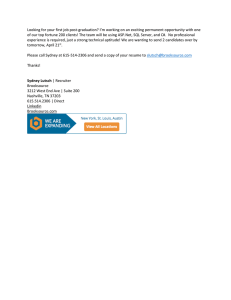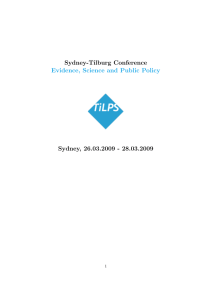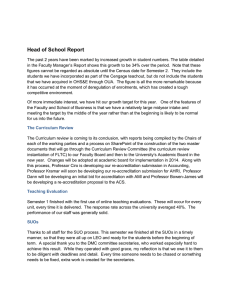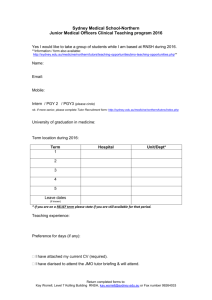INTRODUCTION : Container Revolution Urban intermodal container terminals: The entropy maximizing facility location
advertisement
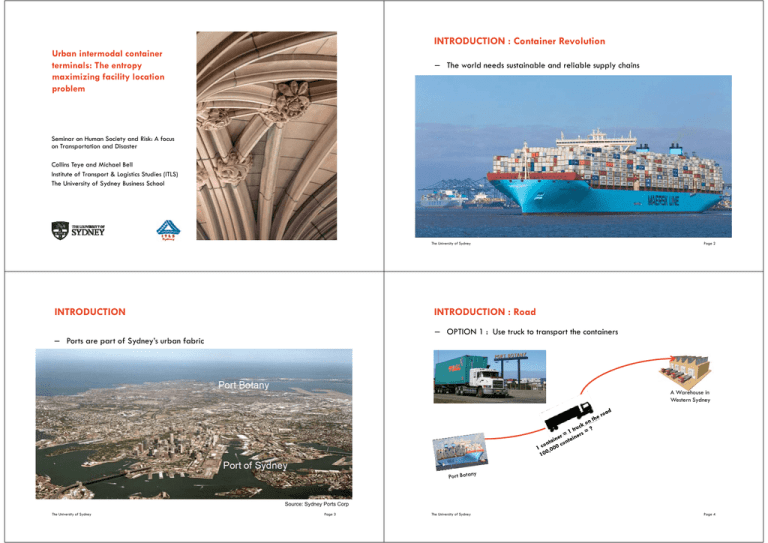
INTRODUCTION : Container Revolution Urban intermodal container terminals: The entropy maximizing facility location problem – The world needs sustainable and reliable supply chains Seminar on Human Society and Risk: A focus on Transportation and Disaster Collins Teye and Michael Bell Institute of Transport & Logistics Studies (ITLS) The University of Sydney Business School The University of Sydney Page 1 INTRODUCTION The University of Sydney Page 2 INTRODUCTION : Road – OPTION 1 : Use truck to transport the containers – Ports are part of Sydney’s urban fabric A Warehouse in Western Sydney Source: Sydney Ports Corp The University of Sydney Page 3 The University of Sydney Page 4 INTRODUCTION : Rail INTRODUCTION : Intermodal Transport ─ OPTION II : Use trains to transport the containers ─ OPTION III : Use intermodal transport Destination Economies of scale IMT The University of Sydney Page 5 INTRODUCTION : Key Research Question The University of Sydney Page 6 INTRODUCTION : Why is Location Important? ─ Where are the best places to locate IMTs? Destination ─ The location of an IMT determines its viability Determines the volume of cargo likely to use the IMT Cargo volume is crucial to make an IMT viable ─ Influence rail mode share The higher the use of the IMT the higher the share of rail ─ Determines the number of trucks that be taken off the road Safer for other road users Less road congestion, especially around the port Less greenhouse gas emission, better environment, more sustainable IMT Where is the best place to locate this terminal ? Port The University of Sydney Page 7 The University of Sydney Page 8 INTRODUCTION : Why the need for Intermodal Terminals? INTRODUCTION : Advantages of IMTs ─ In Australia, containerised trade by volume is set to increase from 6.5 million in 2011 to 11 million TEUs (containers) by 2020 (Shipping Australia, 2011) ─ Trucks currently accounts for over 86% of container trips to and from the ports (Shipping Australia, 2011) ─ ADVANTAGE I: Economies of scale of rail ─ Rail has high carrying capacity, and ─ The larger the volume the cheaper to it is to use rail ─ Poor Management of empty containers: import, export imbalance ─ Congestion around ports with safety & environmental related problems Destination The University of Sydney Page 9 INTRODUCTION : Advantages of IMTs The University of Sydney Page 10 INTRODUCTION : Advantages of IMTs ─ ADVANTAGE II: Economies of distance of rail ─ ADVANTAGE III: Accessibility ─ Less access by rail (can only reach few areas) ─ Flexible and easier access by trucks ─ Rail is cheaper for long distance trips ─ Rail is much greener and safer to other road users Intermodal transport = Combined strengths of rail and truck Unit cost Truck Break-even distance Rail = Exploit economies of scale + Economies of distance Rail Truck = Efficient and flexibility of local pick-up and delivery Distance Truck is cheaper The University of Sydney Rail is cheaper Page 11 The University of Sydney Page 12 INTRODUCTION : Advantages of IMTs INTRODUCTION : Three key IMT markets ─ ADVANTAGE IV: Empty containers ─ Empty container storage at IMTs ─ Efficient management of empty containers ─ ─ ADVANTAGE V: Warehousing & distribution centres ─ Warehousing can be preformed at IMTs ─ Small/medium exporters to consolidate their products for export ─ As a distribution centre for customers/retailers The University of Sydney 3 Key markets ─ A : Regional markets (e.g. moving cargo from Sydney to Melbourne) Source: Russell, L., 2007; Meyrick, 2006 Page 13 The University of Sydney INTRODUCTION : IMTs as Transfer Nodes MAIN RESEARCH QUESTIONS ─ 1. How many IMTs? 3 Key markets ─ B : Exports ─ C : Imports Page 14 Metropolitan IMTs for IMEX markets 2. Where should they be located? ─ Sydney leads Australia in metropolitan IMTs 3. What is the likely demand or usage of the IMTs? 4. What are the likelihoods of the IMTs attracting value adding activities, such as warehousing and empty container storage? Source: Russell, L., 2007; Meyrick, 2006 The University of Sydney Page 15 The University of Sydney Page 16 FACILITY LOCATION PROBLEMS LITERATURE REVIEW : Qualitative Methods Example : Simple Score Method ─ The problem of finding the best locations of intermodal terminals can be placed in the class of Facility Location Problems (FLP) ─ List the candidate sites (e.g. Moorebank, Enfield, Eastern Creek) ─ FLP deals with finding the best placement of facilities and the allocation of demands to the facilities to optimise a given objective ─ List the relevant factors (e.g. Market, Transport, Setup Cost) ─ Score each site (e.g. 0-100 scale) on the factors ─ Select the site with highest average or maxmin score 2 Main Approaches Qualitative Quantitative The University of Sydney Page 17 Market Transport Setup cost Ave Score Moorebank 70 80 70 73 Enfield 55 75 60 63 Eastern 50 60 90 67 The University of Sydney Page 18 QUALITATIVE METHODS : Limitations LITERATURE REVIEW : Quantitative Methods ─ The preference of one alternative or criterion over the other is very subjective, based on the feelings of the analyst or decision-maker ─ The usual approach in the facility location literature is Mixed Integer Linear Programming (MILP) ─ Different analysts might provide different weights leading to possibly entirely different site selections. ─ So far research work on IMTLP are for location of Regional IMTs and based on MILP techniques ─ No idea how the new IMT competes with existing IMTs or no IMT (road direct) ─ The metropolitan Intermodal Terminal Location Problem (IMTLP) is a new area ─ No information on the usage of the terminal and transport costs, which are crucial for cost and benefit analysis ─ No traffic impacts assessment: A facility like this affects and is affected by road network conditions ─ No environmental assessment as usage is unknown The University of Sydney Page 19 The University of Sydney Page 20 LITERATURE REVIEW : Quantitative Methods LITERATURE REVIEW : Quantitative Methods ─ Arnold et al. (2001) provided the first mathematical model for the IMTLP Is the use of MILP models appropriate? ─ Almost all MILP formulations are based on the following assumptions: ─ The general problem composed of two sub-problems: ─ Location problem: Hard to solve ─ Routing problem : Relatively easy to solve ─ Solving both simultaneously : Much harder ─ The origin (where the containers are coming from) and destination (where they are destined) container flows are known and not affected by the IMT locations or changes in transport network conditions ─ The transport costs by all modes are known and also not affected by where the IMTs are located. ─ The Location problem deals the best way of selecting p from the set of T candidate IMTs ─ The Routing problem deals with the best way to route the cargo (origindestination demand) through the IMTs or directly ─ No treatment of empty containers ─ The Routing problem a choice problem The University of Sydney Page 21 GAP IN THE LITERATURE The University of Sydney Page 22 GAP IN THE LITERATURE Problems with the Mixed Integer Linear Programming (MILP) Approach: Problems with Mixed Integer Linear Programming (MILP) Approach: ─ Solutions are ‘All-OR-Nothing (AON) ‘ in nature ─ We expect some form of split between the 2 modes, say 50 or 60% for intermodal transport, or vice versa ─ MILP solution results in shippers making identical decisions in identical circumstances ─ Even if the cost are the same, we will have either all using road direct transport (truck only) or all using intermodal transport Destin ation ─ Also we can’t capture all elements of costs or all factors affecting the decision process ─ The Routing problem is actually a choice problem (intermodal vs road direct) Assume the IMT is located The University of Sydney Page 23 The University of Sydney Page 24 GAP IN THE LITERATURE METHODOLOGY : Entropy Maximization ─ A technique first introduce in statistical mechanics, to relate macroscopic, and measureable properties of physical systems to a description at the molecular or atomic level Can we embed a choice within the location model? ─ Entropy Maximization : Allows us to embed logit models within location models ─ Main Concept: To find the most likely micro state of an object given information about the macro state of the system. ─ More flexible and behavioural than MILP models ─ More efficient to solve than MILP models ─ Maximum entropy has been shown to provide the least biased estimate given the information available (Jaynes, 1957a, 1957b). ─ Can approximate MILP models at the extreme ─ Relation to our problem: ─ The system of interest : Intermodal terminals (IMTs) ─ The micro states of interest : The locations of IMTs and their usage The University of Sydney Page 25 The University of Sydney Page 26 MAXIMUM ENTROPY FACILITY LOCATION PROBLEM METHODOLOGY : Basic Entropy Maximization Model (BEM) Our Model : MIMTLP (Metropolitan IMT Location Problem) ─ Objective function : Finding the most likely intermodal and road direct flows ─ Our model captures the impacts of empty container parks (ECP) in the location problem max X itj InX itj X itj Wikj InWikj Wikj iI kK jJ iI tT jJ ─ Efficient management of empty containers (storage, use and re-positioning) is generally considered one of the key driving force behind the development MIMTs (Meyrick, 2006; Russell, L., 2007; AHRCR, 2007) All states of intermodal flows ─ MIMTLP deals with the use of exactly one IMT in the intermodal transport chain ─ All states of road direct flows ─ We are interested in the most likely state for each mode The University of Sydney Page 27 X itj The cargo flow transported from origin i through IMT t to destination j Wikj The cargo flow transported by road direct from origin i to destination j using ECP k The University of Sydney Page 28 METHODOLOGY : Entropy Maximization METHODOLOGY : Solving the BEM Basic Entropy Maximization Model (BEM) ─ Hard to solve L max X itj InX itj X itj Wikj InWikj Wikj i I t T j J i I k K j J Objective function Subject to: 1 X q Y 2 W q Y itj ij ikj ij i I , j J , t T i I , j J , k T k t tT W 4 kK 5 ikj t T X i I j J W i I j J ikj itj 7 W X itj q B b t H k h t ij ikj i I j J k K f Y 8 t tT Y p 3 6 t c X i I j J t T itj ─ What actually makes the problem hard to solve are the location variables Yt itj C ─ All constraints associated with Yt are hard constraints F ─ If we can find a way of removing the hard constraints, the problem can be much easier to solve or least provide some insight 0 ,1 t T 9 Y t 10 X itj i I , j J t ikj 0 ;W ikj ─ There is no available software for solving BEM 0 i I , j J , k K , t T ─ We use the Lagrangian relaxation technique to do this t T k K k The University of Sydney Page 29 The University of Sydney Page 30 METHODOLOGY : Solving the BEM METHODOLOGY : Solving the BEM Lagrangian relaxation (Relax constraints 1, 2 & 8) Lagrangian relaxation : Divide & Conquer L( X ,W ) max X itj InX itj X itj Wikj InWikj Wikj iI kK jJ iI tT jJ L( X ,W , , ) X itj 1 InX itj itj Wikj 1 InWikj ikj itj ikj qijYt F f tYt iI tT jJ iI kK jJ iI tT jJ tT Subject to: 1 2 X q Y itj ikj ij i I , j J , k T k W kK ikj W i I j J The University of Sydney 9 t T X ikj 8 itj W X itj q B b H t k h k t ij ikj i I j J k K f Y tT t i I j J 6 i I , j J , t T Y p tT 5 t W q Y 3 4 ij 7 Y t ikj c X i I j J t T itj Subject to: itj ikj X t T itj q ij i I , j J 3 Y p t tT F 5 0 ,1 t T t X i I j J 6 i I , j J 10 W 4 kK t Subject to: C X itj 0 ;W ikj 0 i I , j J , k K , t T t T k K Page 31 W i I j J itj B b t ikj H k W 10 X itj ikj 0 ;W The University of Sydney t T 9 7 i I j J k K t ikj ikj h k Y t 0 ,1 t T k K c X i I j J t T itj itj C 0 i I , j J , k K , t T Page 32 METHODOLOGY : Solving the BEM METHODOLOGY : Solving the BEM Two models : Routing model (RM) + Location model (LM) RM X itj 1 InX itj itj Wikj 1 InWikj ikj iI tT jJ iI kK jJ W kK 5 ikj X i I j J 6 W i I j J X t T itj itj itj ikj ij t tT t t ─ The intermodal flows can be expressed as: q B b t ij i I , j J t ikj H k 10 X ikj 0 ;W X itj qij Y p t tT t T 9 W i I j J k K 3 t bt Bt exp citj itj t bt Bt exp citj itj Gk hk H k exp ikj ikj tT 7 itj iI tT jJ q Y F f Y Subject to: Subject to: 4 With some algebraic manipulation, it can be shown that: LM ikj ikj h k Y t 0 ,1 t T k K ─ and the road direct flows as: Wikj qij c X i I j J t T itj itj C Gk hk H k exp ikj ikj b B exp c tT ─ where 0 i I , j J , k K , t T The University of Sydney Page 33 kK t t t itj itj Gk hk H k exp ikj ikj kK t and Gk are constants to be estimated The University of Sydney Page 34 Two Major Extensions METHODOLOGY : Why the interest in Logit Models? ─ Inelastic demand: The models in the literature and that presented here assume that the flow of cargo between each origin-destination pair is: ─ The Logit models : Known for its strength in policy testing ─ Fit a logit model on the output from BEM to capture the behavioural mechanism in the choice and use of intermodal terminals ─ Not influenced by where the IMTs are located: Cargo destined for a warehouse can be re-directed to an IMT (change of destination) ─ The logit model will provide the means to test the relative weights or importance of the drivers of intermodal terminals use ─ Not affected by changes in policy variables: We expect land use policy (e.g. re-zoning, rent or labour) and accessibility to influence the destination of cargo ─ We can also test various policies such a pricing, subsidies, and so on to promote the use of the located terminals ─ Known and unchanged transport costs : No changes in road network conditions ─ Expect to influence and be influenced by where the IMTs are located ─ Traffic impact analysis is very important, at least to ascertain if the road network around the located IMTs have enough capacity to cope with any additional truck traffic without causing local congestion The University of Sydney Page 35 The University of Sydney Page 36 Where we want to get to Numerical Example: MILP problems and EM potential Know where the cargo are produced Generation Models A c c e s s i b i l i t y We use numeric example to ascertain the superiority of the EM over the MILP model in terms of location decision and policy testing The data used in the example were randomly generated but constrained by minimum and maximum values from reports and the literature. Tells us where they are destined Distribution Models The input data are: Location & Mode choice models Location Model (LM) M e a s u r e s 1. Number of origin zones = 1 (e.g. the container port) The locations of the IMTs Choice of mode (intermodal vs road direct) Mode Choice (MC) 2. Number of destination zones = 10 zones 3. Number and location of plausible IMT sites = 5 Network Models Assignment Model Capture changes in road network and updates transport costs Network Skimming The University of Sydney Page 37 4. Number of IMTs to locate = 1 The University of Sydney Page 38 Results : Choice of location - MILP Results : Choice of location – Entropy model The MILP Resulted in IMT 1 as the best site for locating any new IMT with a 50% of the market The MILP Resulted in IMT 2 as the best site for locating any new IMT with a 51% share The Entropy model do not suffer from ‘corner’ solutions. Can be observed that all flows from the origin to destinations 1,2,5,6, and 9 went through IMT 1 E.g. 50% splits of destination 1 demand. MILP would have assigned100% of the demand to either the road direct or IMT 2 mode Destination Cargo (TEUs) 1 476 476 2 193 193 - 3 777 - 777 4 156 - 156 5 109 109 - - 6 1019 1,019 - 7 376 - 376 8 373 - 373 9 688 688 - 10 791 - 791 2,484 50% 2,473 50% Total Mode Share The University of Sydney 4,957 1.20 Road Direct MILP : Base Run 1.00 Mode share (%) IMT 1 0.80 0.60 0.40 Cargo (TEUs) 1 476 IMT 2 238 Road Direct 238 2 193 99 93 0.80 3 777 372 405 0.70 4 156 74 82 0.60 5 109 65 44 Intermodal 6 1019 519 500 Road Direct 7 376 189 187 0.20 0.00 1 Destination 8 373 116 256 9 688 521 167 10 791 323 468 Total Mode Share 2 3 4 5 6 7 8 9 10 Origin-destination movements Page 39 The University of Sydney 4,957 51% 2,442 49% EM : Base Run Mode Share (%) A Clear demonstration of corner point solution of the MILP 0.50 0.40 69% 59% 50% 49% 52% 53% 49% 50% Intermodal 40% 0.30 Road Direct 0.20 24% 0.10 0.00 1 2 3 4 5 6 7 8 Origin-destination movements 9 10 Page 40 Results : Choice of location – Entropy model Results : Policy Testing It determines the demand for each mode probabilistically: Assume we want to testing for policies that can promote more use of the located IMT. Accounting for the fact that not all factors affecting the choice of mode are captured in the modelling process A plausible policy may be road pricing or subsidy for intermodal transport users Implemented by increasing the overall cost of road direct by 5%, 10%, 15% and 20% IMT 2 Keeping the cost of the located IMT unchanged Destination Cargo (TEUs) 1 476 Road Direct 2 193 99 93 0.80 3 777 372 405 0.70 4 156 74 82 0.60 5 109 6 1019 519 500 7 376 189 187 8 373 116 256 9 688 521 167 10 791 323 468 Total Mode Share EM : Base Run 238 65 44 4,957 51% Mode Share (%) 238 69% 59% 0.50 50% 49% 52% 53% 0.40 49% 50% Intermodal 40% 0.30 Road Direct 0.20 24% 0.10 0.00 1 2 2,442 49% 3 4 5 6 7 8 Origin-destination movements 9 10 The University of Sydney Page 41 The University of Sydney Page 42 Results : Policy Testing – Entropy model Results : Policy Testing – Entropy model As we would expect, the intermodal transport share increases marginally as the cost of road direct transport increases. Overall mode share over all origin-destination pairs Also demonstrate marginal distribution of intermodal share with increasing road direct cost. For the share of flows to destination 1 increased from 50% (base) to 64% EM : INCREASE IN ROAD DIRECT COST EM : EFFECT OF INCREASE IN ROAD DIRECT COST 20% Intermodal Road Direct 0.60 0.76 0.78 0.80 0.84 0.89 Mode Share (%) 0.50 0.31 0.33 0.34 0.36 0.40 0.41 0.42 0.43 0.44 0.46 15% 0.50 0.53 0.56 0.61 0.69 10% 0.51 0.53 0.56 0.60 0.67 5% 0.60 0.62 0.65 0.69 0.75 0.47 0.49 0.49 0.51 0.53 0.72 0.48 0.50 0.52 0.55 0.60 0.51 0.54 0.58 0.64 0.50 0.52 0.54 0.58 0.64 INTERMODAL SHARE (%) Base 0.70 0.51 0.49 0.53 0.47 0.55 0.63 0.58 0.45 0.42 0.40 0.37 0.30 0.20 0.10 Base 1 2 3 4 5 6 7 8 9 5% 10% % increase from base in road direct cost 15% 20% 10 OD MOVEMENTS The University of Sydney Page 43 The University of Sydney Page 44 CONCLUSIONS – IMTs have the potential to improve the efficiency, sustainability and reliability of intermodal (containerised) cargo flows – In a context of many shippers exercising choice, the mixed integer linear program (MILP) model is inappropriate due to corner solutions – Entropy maximisation (EM) model provides integrated choice models and is relatively easy to solve The University of Sydney Page 45 The University of Sydney Page 46
